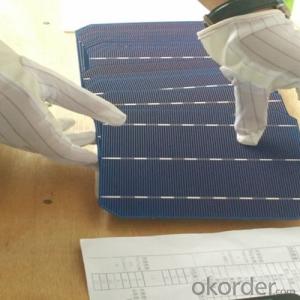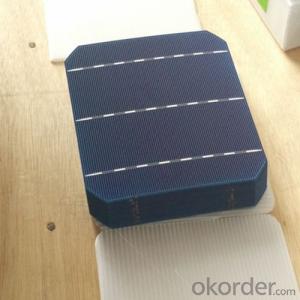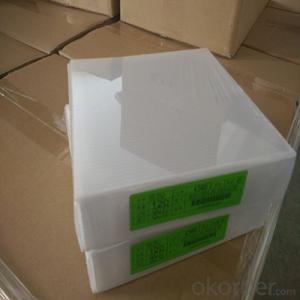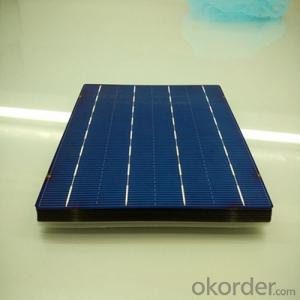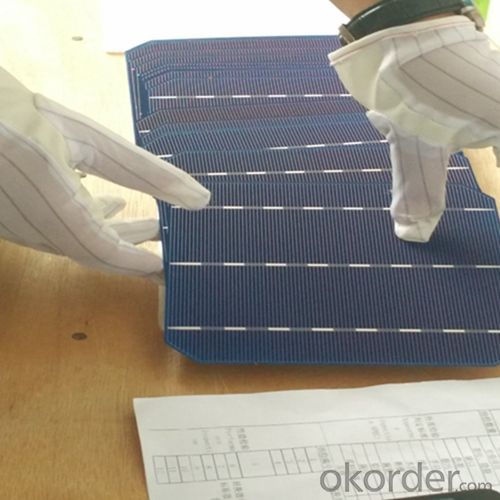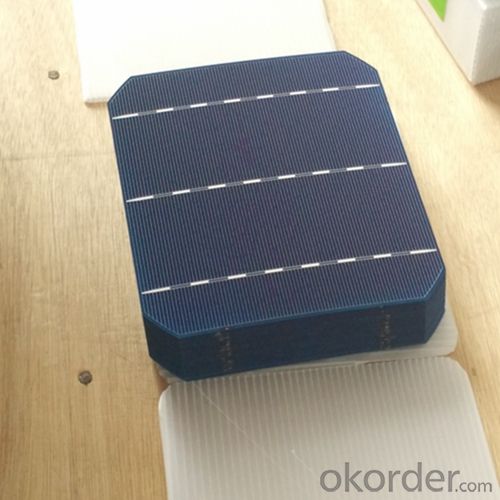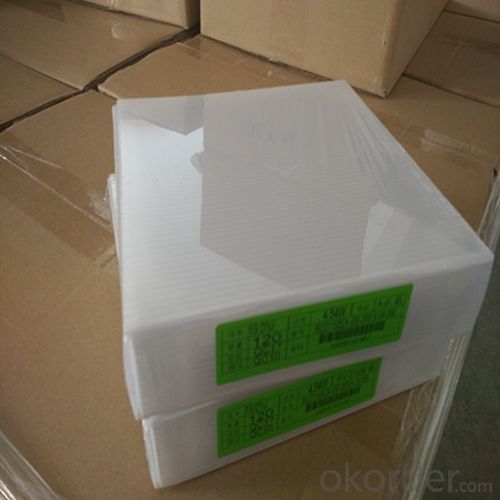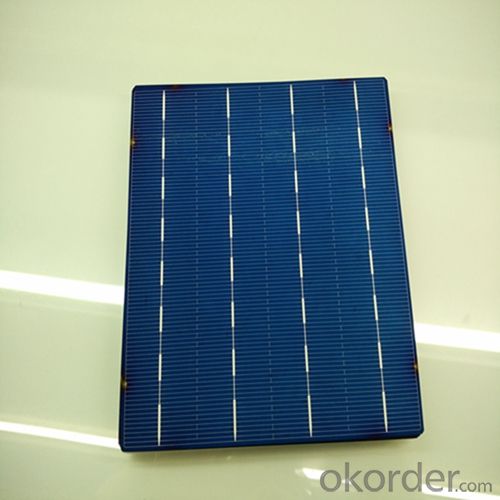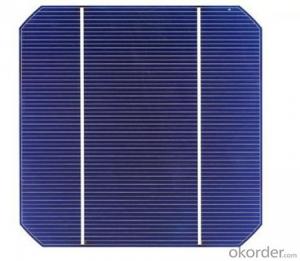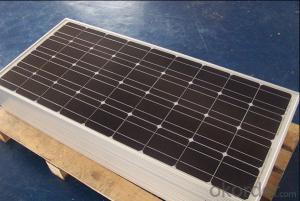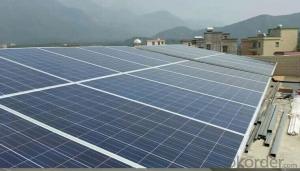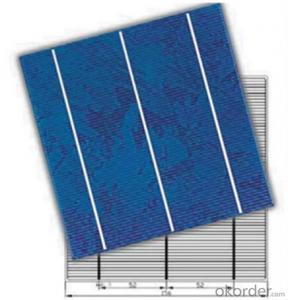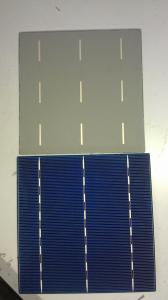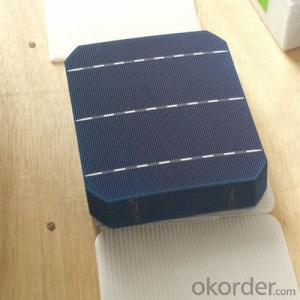Ultrathin Poly 156x156mm2 Solar Cells Made in China
- Loading Port:
- Shanghai
- Payment Terms:
- TT OR LC
- Min Order Qty:
- 6500 watt
- Supply Capability:
- 6000000 watt/month
OKorder Service Pledge
OKorder Financial Service
You Might Also Like
The operation of a photovoltaic (PV) cell requires 3 basic attributes:
The absorption of light, generating either electron-hole pairs or excitons.
The separation of charge carriers of opposite types.
The separate extraction of those carriers to an external circuit.
In contrast, a solar thermal collector supplies heat by absorbing sunlight, for the purpose of either direct heating or indirect electrical power generation from heat. A "photoelectrolytic cell" (photoelectrochemical cell), on the other hand, refers either to a type of photovoltaic cell (like that developed by Edmond Becquerel and modern dye-sensitized solar cells), or to a device that splits water directly into hydrogen and oxygen using only solar illumination.Characteristic of Mono 156X156MM2 Solar Cells
You are gaining energy independence - add battery backup power for even greater energy security
The cost of electricity is only going to rise – insure against that rising cost
Adaptive cells change their absorption/reflection characteristics depending to respond to environmental conditions. An adaptive material responds to the intensity and angle of incident light. At the part of the cell where the light is most intense, the cell surface changes from reflective to adaptive, allowing the light to penetrate the cell. The other parts of the cell remain reflective increasing the retention of the absorbed light within the cell.[67]
In 2014 a system that combined an adaptive surface with a glass substrate that redirect the absorbed to a light absorber on the edges of the sheet. The system also included an array of fixed lenses/mirrors to concentrate light onto the adaptive surface. As the day continues, the concentrated light moves along the surface of the cell. That surface switches from reflective to adaptive when the light is most concentrated and back to reflective after the light moves along
Mechanical data and design
Format | 156mm x 156mm±0.5mm |
Thickness | 210μm±40μm |
Front(-) | 1.5mm bus bar (silver),blue anti-reflection coating (silicon nitride) |
Back (+) | 2.5mm wide soldering pads (sliver) back surface field (aluminium) |
Temperature Coefficient of Cells
Voc. Temp.coef.%/K | -0.35% |
Isc. Temp.coef .%/K | +0.024%/K |
Pm.Temp.coef. %/K | -0.47%/K |
Electrical Characteristic
Effiency(%) | Pmpp(W) | Umpp(V) | Impp(A) | Uoc(V) | Isc(A) | FF(%) |
18.35 | 4.384 | 0.526 | 8.333 | 0.63 | 8.877 | 78.39% |
18.20 | 4.349 | 0.526 | 8.263 | 0.63 | 8.789 | 78.54% |
18.05 | 4.313 | 0.525 | 8.216 | 0.63 | 8.741 | 78.32% |
17.90 | 4.277 | 0.524 | 8.161 | 0.625 | 8.713 | 78.04% |
17.75 | 4.241 | 0.523 | 8.116 | 0.625 | 8.678 | 77.70% |
17.60 | 4.206 | 0.521 | 8.073 | 0.625 | 8.657 | 77.36% |
17.45 | 4.170 | 0.519 | 8.039 | 0.625 | 8.633 | 76.92% |
17.30 | 4.134 | 0.517 | 8.004 | 0.625 | 8.622 | 76.59% |
17.15 | 4.096 | 0.516 | 7.938 | 0.625 | 8.537 | 76.80% |
17.00 | 4.062 | 0.512 | 7.933 | 0.625 | 8.531 | 76.18% |
16.75 | 4.002 | 0.511 | 7.828 | 0.625 | 8.499 | 75.34% |
16.50 | 3.940 | 0.510 | 7.731 | 0.625 | 8.484 | 74.36% |
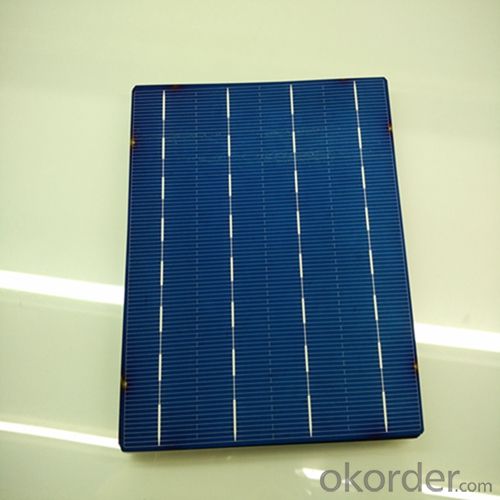
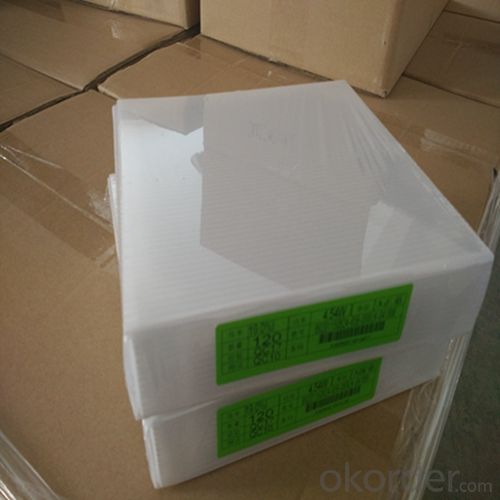
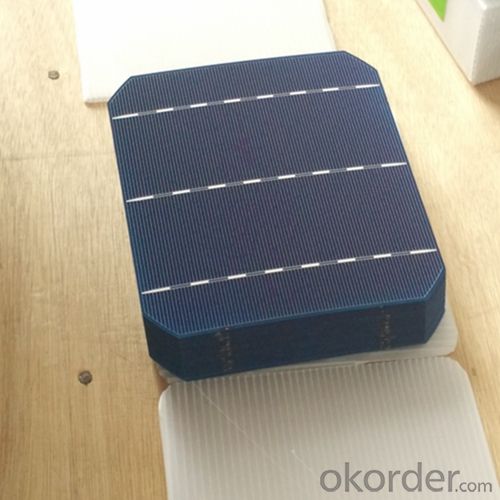
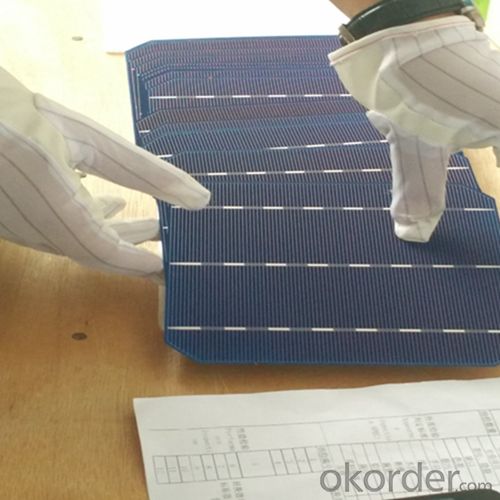
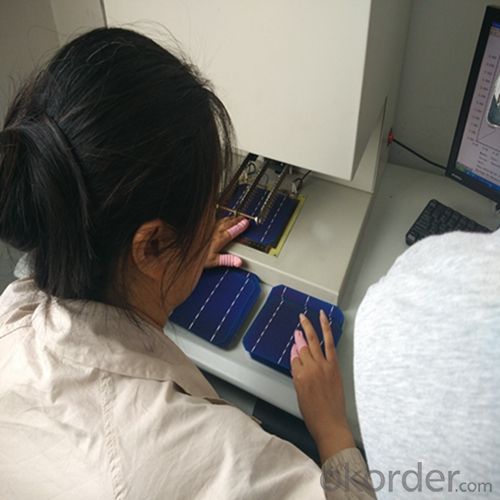 FAQ
FAQ
Q: What price for each watt?
A: It depends on the quantity, delivery date and payment terms, generally Large Quantity and Low Price
Q: What is your size for each module? Can you tell me the Parameter of your module?
A: We have different series of panels in different output, both c-Si and a-Si. Please take the specification sheet for your reference.
Q: What is your size for each module? Can you tell me the Parameter of your module?
A: We have different series of panels in different output, both c-Si and a-Si. Please take the specification sheet for your reference.
- Q: How to define the poly solar cells as the A Grade one?
- It is hard to tell if the poly solar cells you bought has no certificate, ganratees.
- Q: Can solar cells be used for aerospace applications?
- Yes, solar cells can be used for aerospace applications. They are commonly used in spacecraft and satellites to harness solar energy and provide power for various systems and instruments. Solar cells are lightweight, compact, and highly efficient, making them ideal for aerospace applications where weight and space are crucial considerations.
- Q: How can solar cells be used in residential applications?
- Solar cells can be used in residential applications by converting sunlight into electricity to power various household appliances and devices. They can be installed on rooftops or mounted on the ground to capture sunlight. The generated electricity can be used directly in the house or stored in batteries for later use. This renewable energy source reduces reliance on traditional fossil fuels, lowers energy bills, and contributes to a more sustainable and environmentally friendly home.
- Q: Silicon solar cell power generation principle
- When the junction of two different materials formed by the light irradiation, the process of generating electromotive force.The process of the first material absorbs the energy of the photon, resulting in equal number of positive and negative charge, then these charges were migrated to both sides of the knot, The formation of even electricity layer. Although the effect is not generated instantaneous, but the response time is quite short.
- Q: Anybody ever heard of solar roll flexible solar panel?
- The flexible solar cells is more convenient to take with you, and also easy to charge as long as you do know how to use it properly.
- Q: Can solar cells be used in sports stadiums or arenas?
- Yes, solar cells can be used in sports stadiums or arenas. They can be installed on the roofs or other suitable areas to generate renewable energy that can be used to power various systems within the facility, such as lighting, scoreboards, or even charging stations for electric vehicles. Additionally, solar cells can help reduce the environmental impact of these large venues by decreasing their reliance on non-renewable energy sources.
- Q: How do solar cells affect the electric grid?
- Solar cells can have a positive impact on the electric grid by generating clean and renewable energy. When connected to the grid, they can feed excess electricity back into the system, reducing the demand for power from traditional sources. This helps to decrease reliance on fossil fuels and lowers greenhouse gas emissions. However, the intermittency of solar power can pose challenges for grid operators in managing fluctuations in supply and demand.
- Q: Can solar cells be used in harsh climates?
- Yes, solar cells can be used in harsh climates. Solar cells are designed to withstand extreme weather conditions, including high temperatures, cold temperatures, and strong winds. They are often tested and certified to meet specific durability and performance standards, ensuring their reliability in harsh climates. Additionally, advancements in solar technology have led to the development of specialized solar panels that are specifically designed to perform well in extreme weather conditions, such as snow, hail, and sandstorms.
- Q: What is the solar cell?
- The type of solar cells can be divided according to the materials used: silicon solar cells, solar cells and organic semiconductor system of solar cells.
- Q: How can I buy the solar cells wholesale ?
- Please feel free to contact us, a solar cell production company based in Zhuhai, Guangzhou Province. We can offer you the best wholesale price with very good quality.
Send your message to us
Ultrathin Poly 156x156mm2 Solar Cells Made in China
- Loading Port:
- Shanghai
- Payment Terms:
- TT OR LC
- Min Order Qty:
- 6500 watt
- Supply Capability:
- 6000000 watt/month
OKorder Service Pledge
OKorder Financial Service
Similar products
Hot products
Hot Searches
Related keywords
